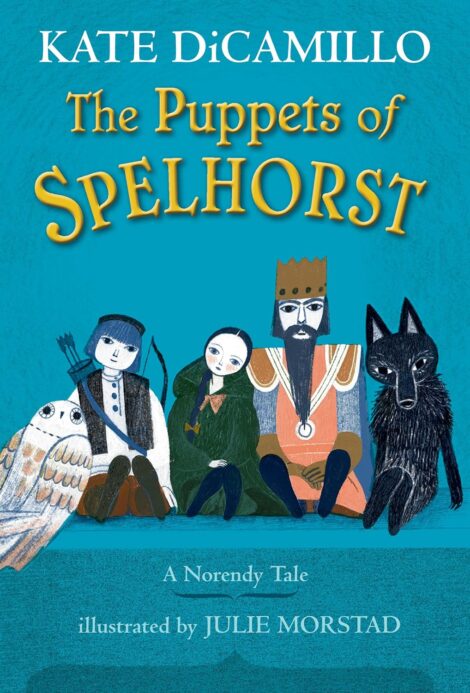
THE PUPPETS OF SPELHORST
From master storyteller Kate DiCamillo comes an original fairy tale–with enchanting illustrations by Julie Morstad–in which five puppets confront circumstances beyond their control with patience, cunning, and high spirits.
Shut up in a trunk by a taciturn old sea captain with a secret, five friends–a king, a wolf, a girl, a boy, and an owl–bicker, boast, and comfort one another in the dark. Individually, they dream of song and light, freedom and flight, purpose and glory, but they all agree they are part of a larger story, bound each to each by chance, bonded by the heart’s mysteries.
From master storyteller Kate DiCamillo comes an original fairy tale–with enchanting illustrations by Julie Morstad–in which five puppets confront circumstances beyond their control with patience, cunning, and high spirits.
Shut up in a trunk by a taciturn old sea captain with a secret, five friends–a king, a wolf, a girl, a boy, and an owl–bicker, boast, and comfort one another in the dark. Individually, they dream of song and light, freedom and flight, purpose and glory, but they all agree they are part of a larger story, bound each to each by chance, bonded by the heart’s mysteries. When at last their shared fate arrives, landing them on a mantel in a blue room in the home of two little girls, the truth is more astonishing than any of them could have imagined. A beloved author of modern classics draws on her most moving themes with humor, heart, and wisdom in the first of the Norendy Tales, a projected trio of novellas linked by place and mood, each illustrated in black and white by a different virtuoso illustrator. A magical and beautifully packaged gift volume designed to be read aloud and shared, The Puppets of Spelhorst is a tale that soothes and strengthens us on our journey, leading us through whatever dark forest we find ourselves in.
- Candlewick Press
- Hardcover
- October 2023
- 160 Pages
- 9781536216752
About Kate DiCamillo & Julie Morstad
 Kate DiCamillo is one of America’s most beloved storytellers. She is a former National Ambassador for Young People’s Literature and a two-time Newbery Medalist. Born in Philadelphia, she grew up in Florida and now lives in Minneapolis.
Kate DiCamillo is one of America’s most beloved storytellers. She is a former National Ambassador for Young People’s Literature and a two-time Newbery Medalist. Born in Philadelphia, she grew up in Florida and now lives in Minneapolis.
Julie Morstad is the illustrator of numerous acclaimed books for young readers, including House of Dreams: The Life of L. M. Montgomery by Liz Rosenberg, When Green Becomes Tomatoes by Julie Fogliano, and Swan: The Life and Dance of Anna Pavlova by Laurel Snyder. She lives in Vancouver, British Columbia.
Praise
“Newbery Medalist DiCamillo applies spare prose and witty conversation in fleshing out the puppets’ desires as well as exploring the power of stories to promote community and offer a path to fulfillment.” —Publishers Weekly (starred review)
“There is a strain of melancholy here, with characters who long for autonomy but whose existence is dependent on the imaginations of others.” —The Horn Book (starred review)
“This collaboration by two masters of their craft—a Newbery Medalist and a Governor General’s Literary Award finalist—will prove irresistible.” —Booklist (starred review)
“Kate DiCamillo’s dazzling first title in the Norendy Tales trilogy is brimming with wit, whimsy, and heart as it follows five puppets fulfilling their thrilling shared destiny.” —Shelf Awareness
Discussion Questions
- Why do you think the sea captain had to have the puppets? Why do you think he responded the way he did when he got home with the puppets?
- The girl puppet considers the rising of the sun “a different thing entirely than the rising of the moon—the sun was more insistent, more certain of its power” (pages 19–20). How would you describe the rising of the sun versus that of the moon?
- The wolf says “the point” is “to capture, to subdue” (page 28). What do you think the king, boy, girl, and owl think is “the point” of their life? What do you think is “the point” of life?
- As they venture deeper into the woods, Martha compares Emma and herself to Hansel and Gretel (page 85). Why would Martha make this connection? Do you agree or disagree with the comparison?
- On pages 137–138, an old woman compliments Emma on her play and shares her own story. Who is this woman? Why do you think that? How does she connect to the story as a whole?
- Why do you think Jane made the choice she did, and why did she take the puppets with her? Based on the final image, where did Jane end up?
- Martha and Emma may be sisters, but they are very different. How would you compare the two of them?
- Songs are a big part of the joy of the puppets’ lives. What song brings you joy? Why does music often bring joy to those who are listening to it?
- How do the illustrations add to your experience of reading the story?
- The Puppets of Spelhorst is described as “an original fairy tale.” What aspects of the book make it a fairy tale?
Excerpt
Once, there was a king.
And a wolf.
And a girl with a shepherd’s crook.
And a boy with arrows and a bow.
And also, there was an owl.
The king had a beard made
of human hair. The wolf’s teeth were bared in a snarl.
The girl wore a green cloak. The arrows in the boy’s quiver were
sharp enough to prick a finger.
As for the owl,
his feathers were real.
The king and the wolf and the girl
and the boy and the owl
lay jumbled together at the bottom of a trunk that had
the word
SPELHORST
stenciled in gold letters
on its lid and sides.
The king and the wolf and the girl
and the boy and the owl were puppets,
and they were waiting for
a story to begin.
CHAPTER 1
THERE WAS ONCE an old sea captain who lived in a small room above a tailor shop. The captain’s name was Spelhorst, and he had no wife, no children, no family. He was alone in the world and took his meals at a café down the street from the tailor shop. There, the old man would sit at a table and stare past everything and everyone as if he were on the prow of a ship, looking out to sea.
One of the captain’s eyes was clouded over with cataracts, but the other eye was a bright and astonishing blue.
On good days, days when his knees did not ache and the weather was fine, Spelhorst walked around the city for hours at a time.
On bad days, he stayed abed, staring at the ceiling, studying its cracks and water stains and spiderwebs. He listened to the door of the tailor shop as it opened and closed. He could hear the murmur of voices, the sound of people requesting things, demanding things.
Sometimes he could hear the tailor shouting at his wife in Italian. Sometimes he could hear the tailor’s wife weeping.
The pigeons on the windowsill of Spelhorst’s room looked in at the old man with bright, disdainful eyes. The birds arrived and departed and returned, and their wings sounded like someone shuffling a deck of cards.
The sea captain paid the pigeons no mind.
He did not even look in their direction.
He kept his eyes on the ceiling.
He tried to think of nothing at all.
And then there came a day—a good day— when Spelhorst’s knees did not ache and the weather was clear, and the old man walked and walked. He ended up very far from the tailor shop, in a part of the city that he did not know, in an alley that was dark and winding.
He came upon a toy shop, and in the window of the shop, he saw displayed a king and a wolf and a girl and a boy and an owl.
The puppets were hanging from fishing line. They were turning slowly in the gust of air made by the opening and closing of the shop door.
Spelhorst stopped. He took his cap from his head and stared at the puppets.
There he was: a man without family, a man without children or grandchildren, a man utterly devoid of whimsy or wonder, staring at a toy store window, bewitched entirely by puppets.
But Spelhorst was not staring at all of the puppets. He was staring at one puppet only— the girl with the cloak and the shepherd’s crook.
The girl had the heart-shaped face and violet eyes of someone Spelhorst had loved long ago.
Loved and lost.
Loved and lost, loved and lost, the everrepeating story of the world.
“I must have her,” Spelhorst said aloud to no one.
He put his hat on his head, went into the store, and announced to the clerk that he wished to purchase one of the puppets on display in the window.
“You cannot buy just one,” said the clerk. “They belong together.”
“I want the girl puppet only,” said Spelhorst. “The puppets must be purchased together or not at all,” said the clerk, “for they are in a story.”
Spelhorst stared at the clerk.
Story? What did a story matter to him?
The door to the shop opened and closed. The puppets danced in the small wind, and the girl puppet twisted about suddenly so that she was facing the captain, looking at him.
Spelhorst closed his eyes and then opened them again. He said, “Very well. All of them.”
He took the puppets with him back to the room above the tailor shop.
He threw the king and the wolf and the owl and the boy into the trunk at the foot of his bed.
But the girl puppet Spelhorst propped up on the table so that he might look into her violet eyes.
He sat on the bed and stared at her. He said, “I am sorry. I am sorry, Annalise. I am sorry.” He put his head in his hands, and then he got up from the bed and sat down at the table and took up a pen and paper. He wrote for a long time.
When he was done, he folded the paper and put it in the trunk, and then the old man sat at the table and wept.
Outside the room, perched on the windowsill, the pigeons looked in at the sea captain and made noises of despair and disapproval.
It grew dark.
Spelhorst did not light the lamp.
He got into bed and cried himself to sleep as if he were a small child.
